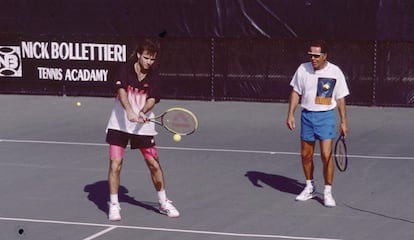Legendary US tennis coach Nick Bollettieri, maker of Grand Slam champions, dies at 91
The guru molded stars including Andre Agassi, Martina Hingis, Monica Seles, Maria Sharapova, Boris Becker and Anna Kournikova at his Bradenton academy in Florida


Nicholas James Bollettieri, considered the goldsmith of US tennis who coached many of the top stars of the game, died on Sunday at his home in Florida, his family said in a statement. Bollettieri’s place in the annals of tennis was secured at his Bradenton academy, where he oversaw the development of future Grand Slam champions including Andre Agassi, Monica Seles, Martina Hingis, Boris Becker, Jim Courier, Mary Pierce and Maria Sharapova, as well as promising stars whose careers did not pan out in the same way, such as Marcelo Ríos and Anna Kournikova, among others. An iconic and singular figure with his coppery brunette hair, gold rings and permanent sunglasses, Bollettieri’s strict methods catapulted at least ten world number ones to the top as he turned his reputation as a prestigious trainer into a business model.
Born in 1931 in Pelham, New York, the son of Italian immigrants, Bollettieri started playing tennis in college and after a stint in the army and as a teacher at a resort in Puerto Rico, he borrowed $1 million from a friend to set up his academy a seedbed with a pseudo-military profile that he built in 1978 on a 40-hectare field.
Bollettieri always boasted that he did not possess excessive technical knowledge, but pure intuition. He decided to base his program on observation and the discipline of his method, under a regime of extreme competition. He created champions, but was occasionally accused of creating automatons as well. In the words of Agassi, an eight-time major champion who completed a career Golden Slam, Bradenton was “a glorified prison camp […] a Lord of the Flies with forehands.”
The Bollettieri factory started to roll when Kathleen Horvath, a promising young player, made her US Open debut aged 14 years and five days old: there has been younger debutant since Horvath’s appearance in 1979. However, it soon became clear that Horvath was not Bollettieri’s golden goose and she was discarded, simply and crudely, adding to Bollettieri’s growing reputation as a hard taskmaster. His doctrine: “It’s about hitting hundreds of tennis balls for four or five hours daily, of squeezing schoolwork between training sessions, of spending three or four weekends each month at tournaments. Nothing is going to come by accident. If it does, it’s a one-time victory. Success is about blood, sweat, tears, frustration and the determination to achieve it.”
Over the past 30 years an endless string of talent has passed through Bradenton – the Williams sisters were briefly students – but only a select few made Bollettieri’s grade. His most famous and profitable bet was always Agassi. The Las Vegas-born showman was famously pushed into tennis by his overbearing father and was seen as the rebel without a cause of the sport until the Grand Slams started to arrive, his first coming on the grass of Wimbledon in 1992. Bollettieri admitted that he indulged his prodigy to a certain extent: God blessed me with the ability to read people,” he said in an interview with Tennis Now. Andre, you had to talk to softly [...] If I had given up on Andre, I probably never would have made it.”
During the 1990s, Bradenton became a mecca of formative tennis for promising players from across the world. There, Bollettieri not only produced champions, but also “children prepared to face the dangers of life.” It was not always a marriage made in heaven. Bollettieri’s relationship with Seles’ family was stormy. “By far the most demanding I’ve ever worked with,” he observed. But no sooner had the future world number one and winner of nine Grand Slams departed than a platinum-haired girl who “had it all” arrived at the academy. However, Bollettieri swiftly noted a flaw: “Kournikova had a superior backhand, like her volleying, but she didn’t have a forehand. Her mother wouldn’t let me change it and if a mother doesn’t want something…” Kournikova enjoyed more success in doubles than singles but was the prototype for what would soon become the Bollettieri brand.

Almost immediately, the Bradenton laboratory hit on the perfect formula: esthetics, media power and results. Maria Sharapova. Recommended by the legendary Martina Navratilova, Sharapova and her family rolled the dice. They arrived in Florida with “$700 in their pocket,” and the nine-year-old Sharapova earned a scholarship. “She was antisocial, she only thought about work,” Bollettieri said of the Russian future number one. “She was there for something; she had a mission: to beat all the others.”
In 2014, Bollettieri was inscribed in the Tennis Hall of Fame. He had started out giving classes for $4 an hour, a price that eventually rose to $1,000. In 1987, he sold the academy to IMG, but he continued to preside over it. Despite his fearsome reputation, many of his protegees remembered him fondly. Courier once said: “He was like a father and we were vying for his love.” Becker, who stunned tennis when he won Wimbledon aged 17, said: “He is not just a tennis coach, he is a life coach.”
However, the final word belongs to Agassi, the player with whom Bollettieri will always be inextricably linked, who described Bradenton in his autobiography, Open: “We eat gruel, beige meats and gelatinous stews and gray slop poured over rice, and sleep in rickety bunks that line the plywood walls of our military-style barracks. We rarely leave, and we have scant contact with the outside world. The constant pressure, the cutthroat competition, the total lack of adult supervision – it slowly turns us into animals. A kind of jungle law prevails.”
Sign up for our weekly newsletter to get more English-language news coverage from EL PAÍS USA Edition
Tu suscripción se está usando en otro dispositivo
¿Quieres añadir otro usuario a tu suscripción?
Si continúas leyendo en este dispositivo, no se podrá leer en el otro.
FlechaTu suscripción se está usando en otro dispositivo y solo puedes acceder a EL PAÍS desde un dispositivo a la vez.
Si quieres compartir tu cuenta, cambia tu suscripción a la modalidad Premium, así podrás añadir otro usuario. Cada uno accederá con su propia cuenta de email, lo que os permitirá personalizar vuestra experiencia en EL PAÍS.
¿Tienes una suscripción de empresa? Accede aquí para contratar más cuentas.
En el caso de no saber quién está usando tu cuenta, te recomendamos cambiar tu contraseña aquí.
Si decides continuar compartiendo tu cuenta, este mensaje se mostrará en tu dispositivo y en el de la otra persona que está usando tu cuenta de forma indefinida, afectando a tu experiencia de lectura. Puedes consultar aquí los términos y condiciones de la suscripción digital.
More information
Archived In
Últimas noticias
The struggle for hegemony: US and China compete for supremacy in a turbulent landscape
Literature that crosses the line: Cocaine in books
Nora Sandigo, ‘the great mother’ who offers refuge to migrant families in the United States
The secrets of the Washingtonia palm, named after the first US president
Most viewed
- David King, chemist: ‘There are scientists studying how to cool the planet; nobody should stop these experiments from happening’
- Mexico completes its trade shift with the entry into force of tariffs on China and countries without trade agreements
- Alain Aspect, Nobel laureate in physics: ‘Einstein was so smart that he would have had to recognize quantum entanglement’
- Reinhard Genzel, Nobel laureate in physics: ‘One-minute videos will never give you the truth’
- Oona Chaplin: ‘I told James Cameron that I was living in a treehouse and starting a permaculture project with a friend’









































